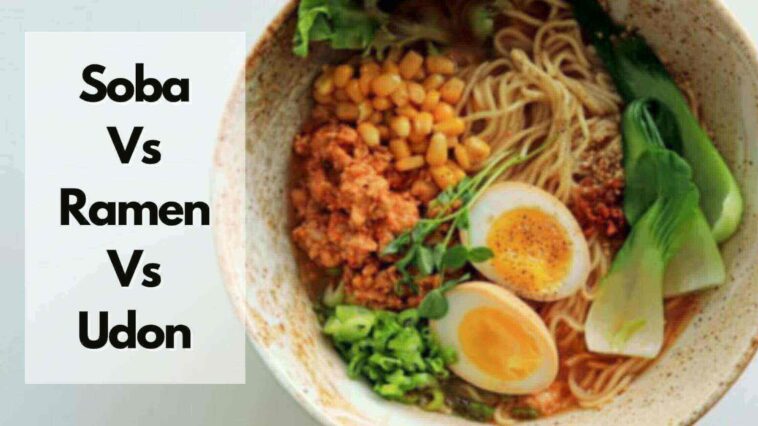You may think only of Sushi when you think of Japan, but noodles are an iconic part of this country. So trying to choose between Soba vs Ramen vs Udon? Let’s decide once and for all!
Japan loves its noodles, whether ramen or any other variety. You will find tons of noodle joints serving different varieties and flavors of noodles. And I can guarantee that you’re going to have a hard time choosing between soba vs ramen vs udon!
Whether it’s a quick lunch or an important religious gathering, noodles make an essential ingredient.
Usually, when we think of Japanese noodles, it’s ramen that instantly comes into our mind. But the world of Japanese noodles has more to it than just the popular ramen noodles.

While there are several types, I’m going to discuss the three major types – Soba Vs Ramen vs Udon. While both varieties are loved by people, it is natural to have favorites.
What is the difference between Soba Vs Ramen Vs Udon
Here’s a quick summary of Soba vs Ramen Vs Udon
While Ramen was the most recent addition to Japan’s cuisine, it is the most popular worldwide.
The biggest difference between soba and ramen noodles, anybody would notice, is the flavor. This is because Ramen is made with wheatflour and soba is made with mostly buckwheat. Another notable difference between Udon, ramen, and Soba is that Udon is cut into thicker pieces while ramen is thinner. Udon is also chewier when compared to ramen and Soba
So let’s break down these three people’s favorites and learn the differences? So, without further ado, let’s get on with our battle.
- Related: Best Japanese Instant Ramen
- Related: A Crash Course in Japanese Home and Kitchen
- Related: Kaki: The Miraculous Japanese Fruit
It’s Soba vs Ramen Vs Udon time! Are you ready?
Page Contents
Soba Vs Ramen Vs Udon!
| Soba Noodles | Ramen Noodles | Udon Noodles |
| Wheat Flour, Buckwheat, water | Wheat flour, salt, water, kansui | Wheat flour, salt, water |
| Spaghetti like | Can be thick or thin | Thick noodles |
| Firm texture | Firm texture | Chewy texture |
| Nutty flavor | Rich, meaty flavor from the broth | Light, blandish flavor. |
Related: Check out this Japanese cookbook and make a delicious Ramen at home!
Soba Vs Udon Vs Ramen – Which is Healthier?
Soba noodles are the healthiest of the three, followed by udon noodles and then ramen noodles.
- Soba noodles are made from buckwheat flour, which is a good source of protein, fiber, and minerals. They are also low in calories and fat.
- Udon noodles are made from wheat flour, which is also a good source of protein and fiber. However, they are higher in calories and fat than soba noodles.
- Ramen noodles are made from wheat flour and kansui, a type of alkaline water that gives them their characteristic yellow color and chewy texture. Ramen noodles are higher in calories, fat, and sodium than either soba or udon noodles.
In addition to the type of noodle, the toppings and broth that you choose can also affect the healthfulness of the dish. For example, a simple broth with light toppings will be healthier than a broth that is high in sodium and fat.
Here is a table summarizing the healthfulness of soba, udon, and ramen noodles:
| Noodle | Calories | Fat | Protein | Fiber | Sodium |
| Soba | 113 calories | 2 grams | 5 grams | 4 grams | 1 mg |
| Udon | 170 calories | 2 grams | 7 grams | 1 gram | 110 mg |
| Ramen | 138 calories | 2 grams | 6 grams | 1 gram | 890 mg |
As you can see, soba noodles are the lowest in calories, fat, and sodium. They are also a good source of protein and fiber.
Udon noodles are higher in calories and fat, but they are still a good source of protein and fiber. Ramen noodles are the highest in calories, fat, and sodium.
So, if you are looking for the healthiest option, soba noodles are the way to go. However, if you are looking for a noodle that is higher in protein, udon noodles may be a better choice.
And if you are not concerned about the healthfulness of the noodle, ramen noodles can still be enjoyed in moderation.
Let’s get into the details of Soba Vs Ramen Vs Udon!
What Is Ramen Noodles Made Of?
Let’s begin with the noodles the whole wide world is acquainted with – Ramen!
You must have seen endless Ramen Challenge videos on YouTube, and chances are, you must have tried them out yourself too.
So, what is it that makes Ramen noodles so infinitely popular amongst the masses?
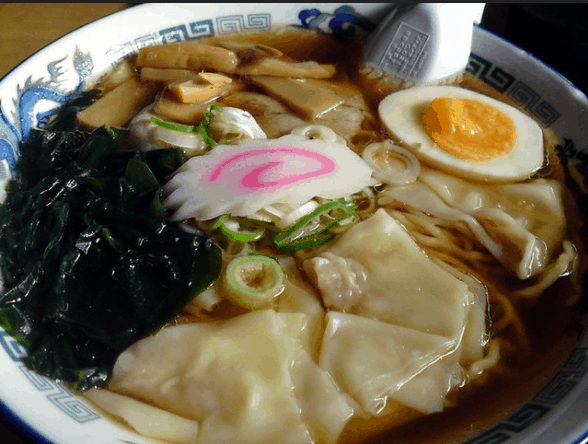
Ramen noodles is popular throughout Japan, with each region specializing in its particular variety and flavor. A bowl of ramen noodles with a side dish of fried rice makes a complete lunch.
Authentic Ramen noodles are typically wheat-based and are darker yellow as compared to store-bought ramen noodles. Also, the legitimate ramen is so much tastier than our store-bought ones.
The ramen should be long, springy, and must be firm to chew.
The best way to chow down a bowl of ramen is with sodium dredged soup; the soup brings out the flavor of the ramen and adds extra deliciousness.
Related: Eat this fruit to lower your blood sugar!
Ramen Noodles Broth!
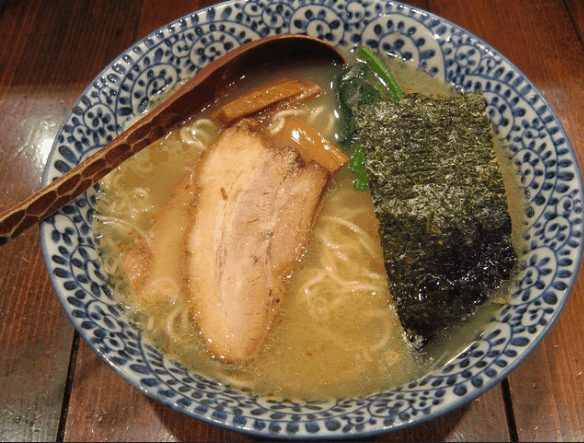
The one thing that separates Ramen from the rest of the Japanese noodles is its broth. There are dozens of varieties of broth to enhance the taste of ramen.
The consistency of the broth ranges from rich and hearty to light and refreshing. With so many varieties, you will never have to eat the same ramen again.
Change the broth, twist it a bit, and voila! You have a whole new world of flavors in a bowl right in front of you.
The most popular broths are the simple soy sauce broth called shoyu and salt-based broth called shio.
There are also other popular varieties available such as miso and tonkatsu, which is the pork bone-based broth.
Related: Top Conveyor Belt Sushi Restaurants to visit in Tokyo!
Ramen Noodles Toppings!
You must have seen delicious-looking pictures of Ramen online. What makes Ramen so mouthwatering (apart from the broth and the noodles) are the toppings.
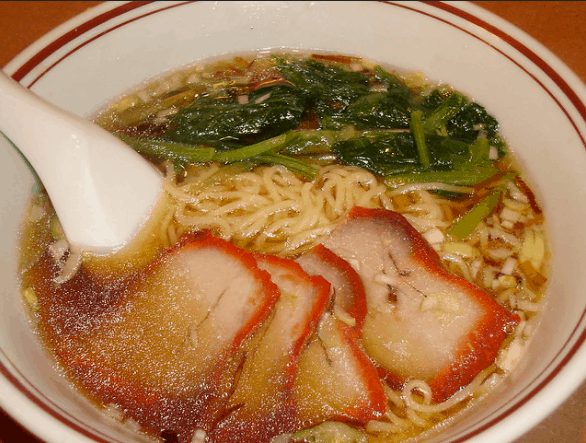
These toppings add texture and flavor to the ramen. And the best part of all? You can customize the toppings and create something unique for yourself!
Usually, ramen is topped with a piece of nori (an edible piece of seaweed), a slice of roast pork, bamboo slices, and half a boiled egg.
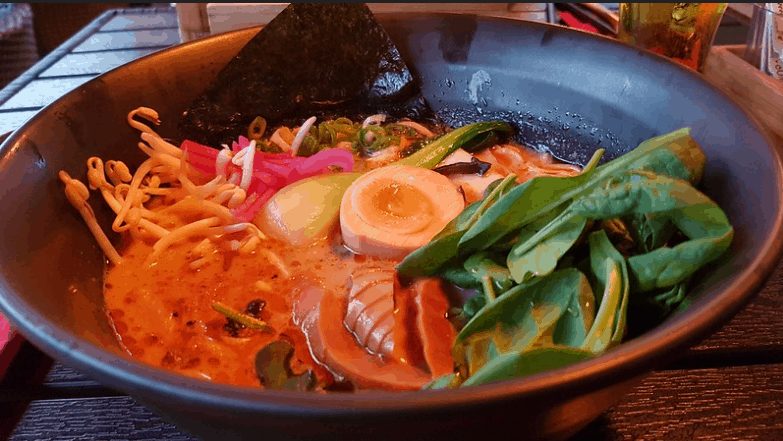
But you don’t have to keep yourself limited to these toppings only. Like I said before, be adventurous and add anything that catches your fancy.
Corn, chicken, green onions, and more heighten the flavor of the ramen noodles.
What is Soba?
Soba noodles is a variety of noodles that not many people outside of Japan are much acquainted with.
However, soba is a delicious noodle that has a refreshing taste. Soba dishes are mouthwatering and will entice your taste buds right from the first bite.
Soba noodles are made from buckwheat flour traditionally from Hokkaido, which gives it a rich aroma.
The buckwheat flour gives Soba a distinctive brown color. Unlike ramen, soba has a softer, less elastic texture.
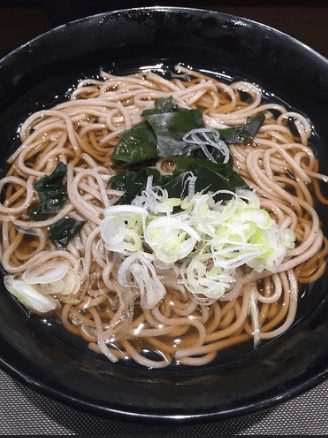
The texture of soba noodles is such that it easily absorbs the broth, increasing the flavor and making it more delicious.
Soba is springy and thick, which is why some people compare it to spaghetti. A popular dish is soba noodles with tsuyu sauce, bonito flakes, kelp, and shiitake mushrooms.
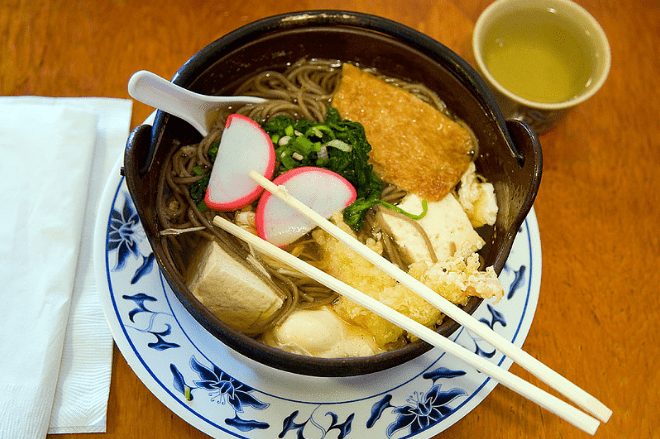
Even though it is said that soba is made using buckwheat flour, it still contains some amount of wheat flour.
However, if you are looking for soba that is 100 percent made of buckwheat flour, ask for Towari and Juwari Soba. These two varieties are made completely of buckwheat flour.
How To Eat Soba Noodles?
There are two ways you can eat Soba: cold or hot.
#1 — Cold Soba
Usually, soba noodles are served chilled on a bamboo tray. However, if you wish, you can order soba in a soup.
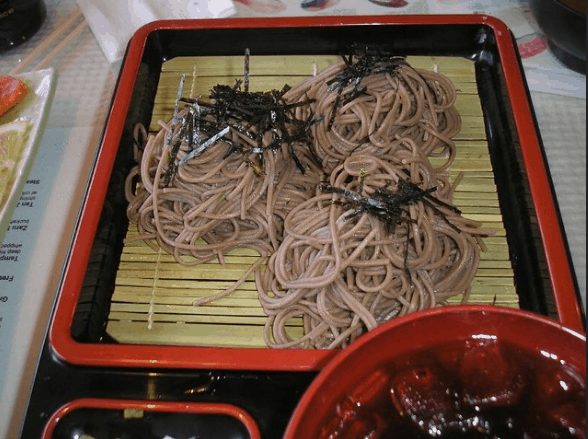
If you order chilled soba, you will notice that the broth that comes with it is fairly strong. It is made of soy sauce, dashi, and mirin (rice wine). The broth is served in a tiny bowl/cup.
To enjoy the deliciousness, you pick up a tiny amount of soba and dip it in the broth. The noodles will absorb the flavorful broth and give you an exciting burst of flavor.
Cold soba also comes with toppings sometimes. You will also find your cold soba wrapped in seaweed, or served as a salad.
Soba can also be flavored with green tea powder, seaweed, mugwort, or wheat. Adding all these flavors enhance the taste and make it delicious.
Some restaurants give you hot water along with the broth. You can use it if you still have some broth left after the soba gets over.
Plus, you can water down the broth and drink it like a soup. YUMMY!
Related: Why are fruits in Japan so expensive!
#2 — Hot Soba
You can also enjoy your soba hot with broth, just like ramen. The most popular ingredients in hot soba are long onion and mixed chili powder.
There are different ways in which we can mix and match our ingredients in hot soba, as per your taste. Just like ramen, go creative and add whatever toppings that you love to create your own custom-made hot soba.
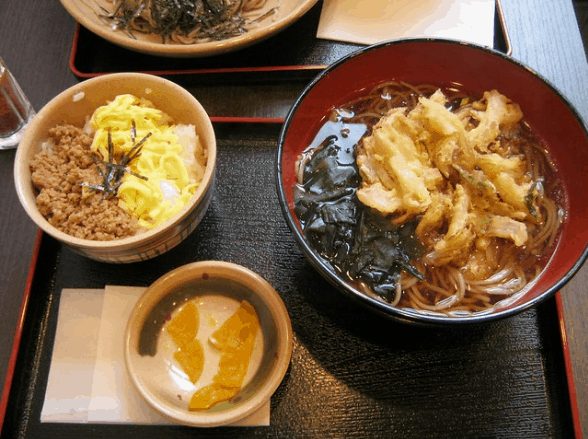
The most popular soba dishes are cha soba, kawara soba, izumo soba, togakushi soba, wanko soba, and hegi soba.
Regional Soba dishes
Izumo Soba noodles
Izumo soba noodles originated from the Izumo region in the prefecture of Shimane. In Japan, this noodle dish is considered to be one of the three best styles of soba noodles. The specialty of the Izumo soba noodles is that it’s made out of the entire buckwheat grain which makes them extremely nutritious. It has a strong aroma and the taste is quite flavorful.
Izumo soba is usually served in three-tier stackable dishes with many toppings on the side and dipping sauces which adds extra flavor and kick to the noodles. Some of the best condiments that go well with Izumo soba noodles are seaweed and green onions. After finishing the first tier of noodles the sauce will be poured to the next tiers and this makes the sauce to suck up all the flavors in the noodles.
Cha Soba noodles
Cha soba noodles is a very unique noodle dish in Japan. It’s made out of buckwheat flour but has a flavor of green tea powder or matcha. Cha soba noodles are widely available in the region of Uji, which is a city famous for its mass production of matcha in Japan. Hence, why the noodles have a green tea flavor.
The matcha powder gives the soba noodles a light green color making them look very appealing to the eye. It’s a flexible dish that can be served with any broth either hot or cold. Chilled cha soba noodles are eaten in Japan during summer. They are usually topped with savory soy sauce and dashi sauce. The condiments and the chilled cha soba noodles are very refreshing to eat and add a whole lot of flavor to the dish. This is the ideal noodle dish for those who are on a strict diet plan.
Health Benefits Of Soba
Buckwheat, the core ingredient in soba noodles, has a wealth of health benefits:
- High Protein: it is high in protein, with one cup of soba containing about 6 grams of protein, and a good source for thiamin which helps with healthy cell growth.
- Reduces Cholesterol: Buckwheat is also known to reduce cholesterol and blood pressure which aids in improving cardiovascular health. Furthermore, soba is considered healthier than any type of pasta.
- Low Calories: Soba noodles are low in calories and carbohydrates, making it the healthiest option for you.
- Amino Acids: Soba also contains all eight essential amino acids that provide you with tons of health benefits.
Related: Why are melons in Japan so expensive?
What Is Udon Noodles?
Udon noodles are made of wheat flour, salt, and water. Udon noodles is more closer to Ramen than Soba. The main difference between Udon and Ramen is that, Udon noodles are not accompanied with a plethora of toppings. The concept of Udon noodles is that it’s supposed to be served as a simple dish.
Udon noodles are thick noodles so it’s pretty filling just by itself without any special toppings.
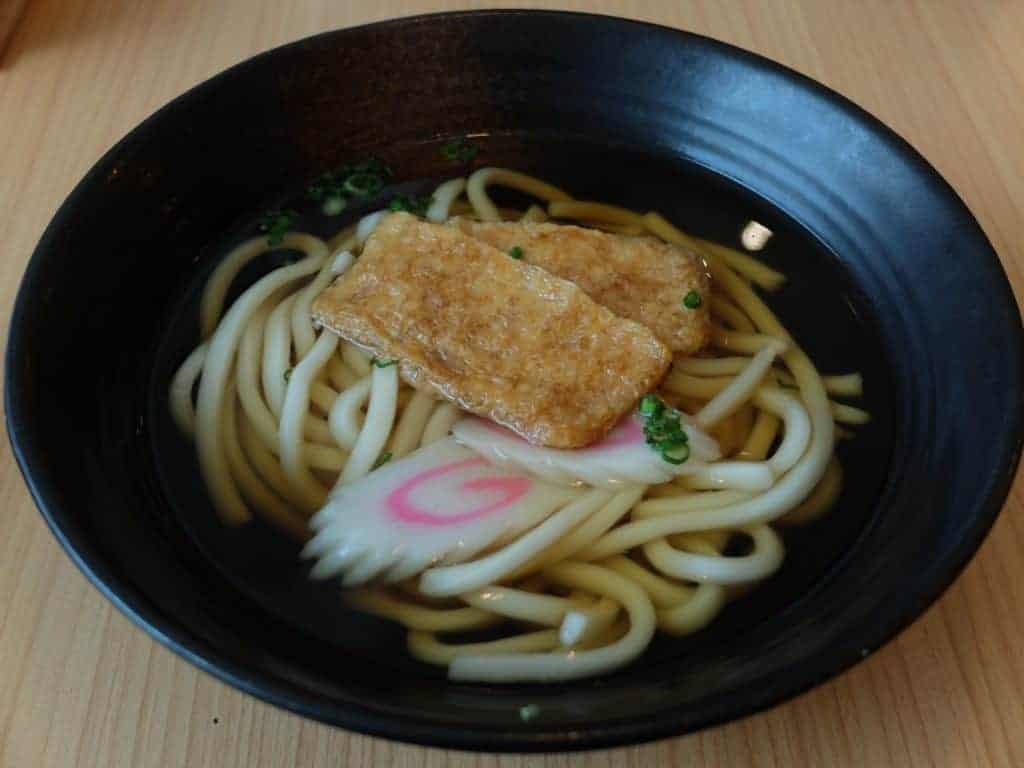
Types Of Udon Dishes
The similarity between Udon and Soba is that it can be enjoyed hot or cold. And depending on your preference, you can choose the toppings and broth. Different parts of Japan have their own traditional version of Udon dish.
The broth used for Udon noodles is usually either meat or fish with an assortment of ingredients of your choice added to the broth! YUM!
Common Udon Dishes
- Hot Udon: Kake Udon is prepared in a broth with kamaboko and scallions. Making Kake Udon is simple, fast and absolutely delicious! Tempura Udon is also another type of hot Udon that has prawns tempura or tempura fritters.
- Curry Udon: in this one, we introduce curry powder in the broth along with Udon noodles. This one is a bit heavier than other versions of Udon.
Regional Udon Dishes
Sanuki Udon Noodles
Sanuki udon noodles are the most famous udon dishes in Japan. It originated in the Kagawa Prefecture in Japan. It was regularly eaten by the people in the Kagawa region. Sanuki udon noodles have a very unique texture that’s neither too hard nor too soft. It’s a bit firm and chewy and can be easily slurped while eating.
The best toppings that go well with Sanuki udon noodles are beaten egg and condiments like soy sauce or fish broth.
Any type of broth complements Sanuki udon noodles and it’s always served with a lot of broth that adds more flavor to the noodles. Sanuki udon noodles can be served either hot or cold with some dipping sauces and condiments.
Mizusawa Udon noodles
This is another popular type of udon noodles in Japan that originated from the Gunma Prefecture. It’s also one of the top three varieties of udon in Japan.
The noodles are made from wheat flour that’s grown in the Gunma region, spring water from Mount Haruna, and a bit of salt. They are kneaded and then left to dry for two days.
The texture of the Mizusawa udon noodles is slightly thick and firm and has a light translucent white color. They are usually eaten chilled with dipping sauces like soy sauce or sesame sauce and garnished with dried seaweed.
The Mizusawa udon noodles can be paired with any type of soup broth and can be conveniently slurped while eating.
Related: Here are some yummy options for you to try at 7-eleven in Japan!
So, Which One Is Better? Soba vs Ramen Vs Udon – The Final Verdict
After all the information about these two popular varieties of Japanese noodles, the question remains the same – which one is better?
Well, it is up to you to decide which one is better. Everyone has their own tastes and preferences. And whether you like soba, ramen, or udon, you are surely going to find your favorite taste in the world of Japanese noodles!
Also Read:


